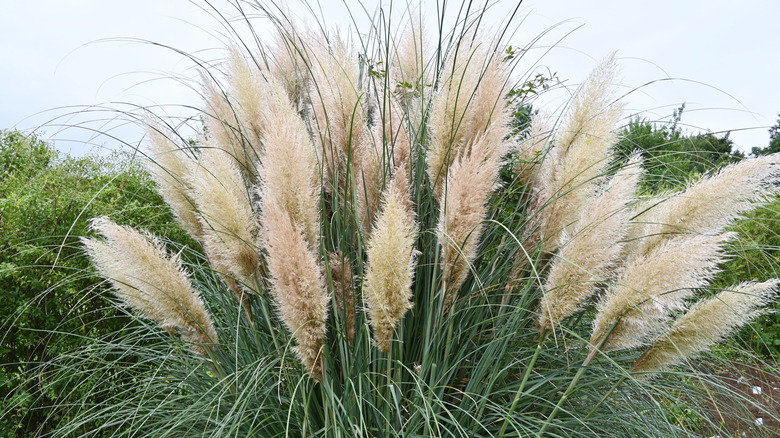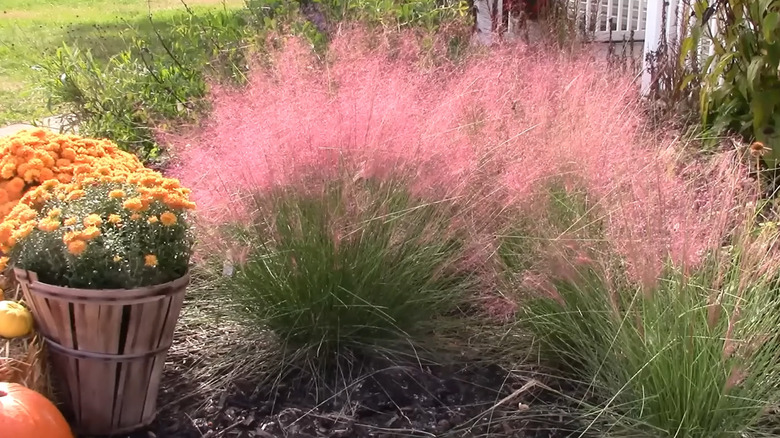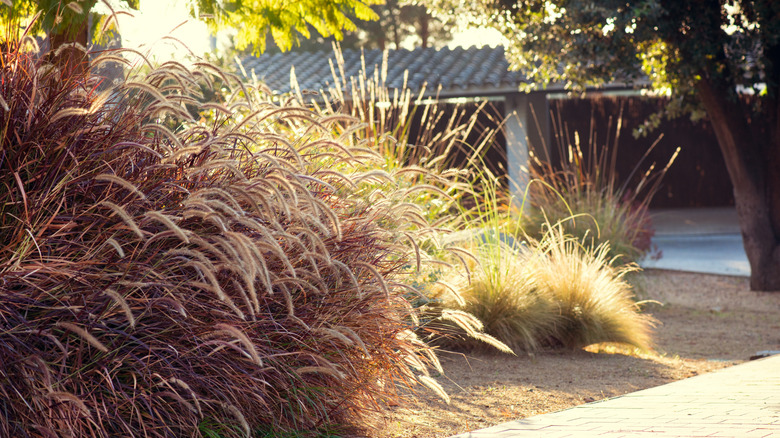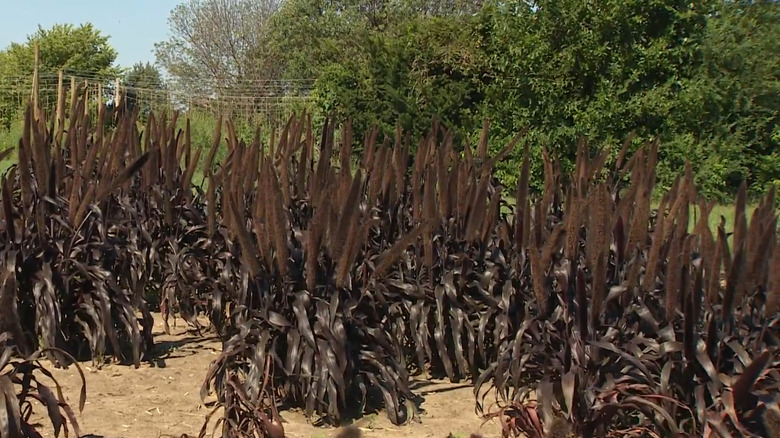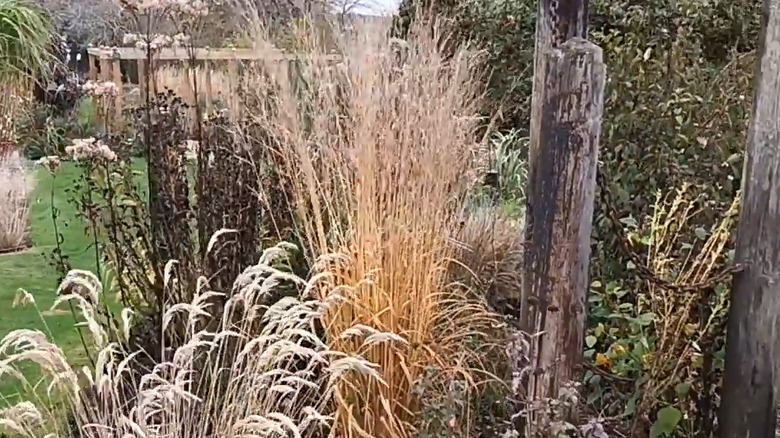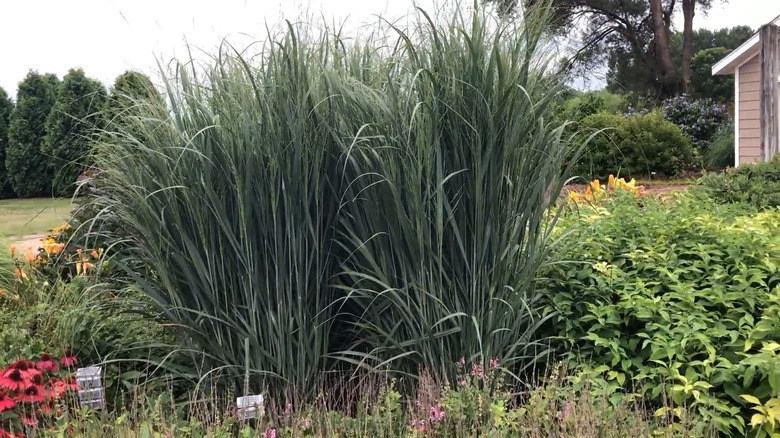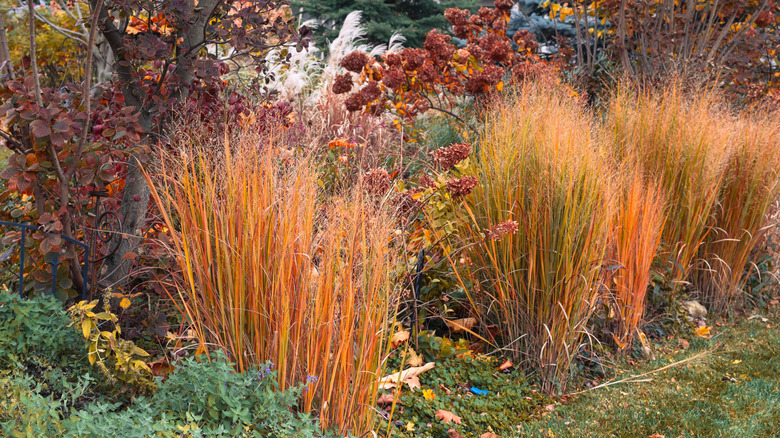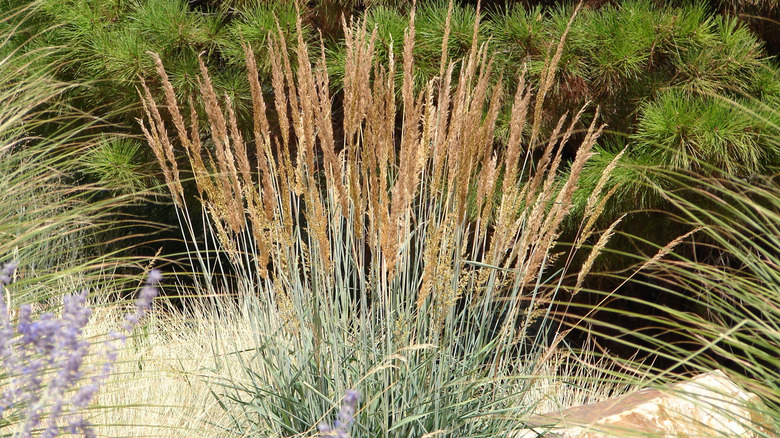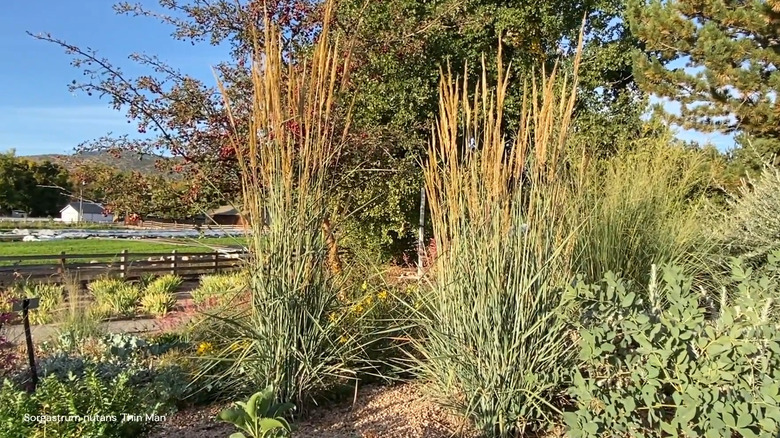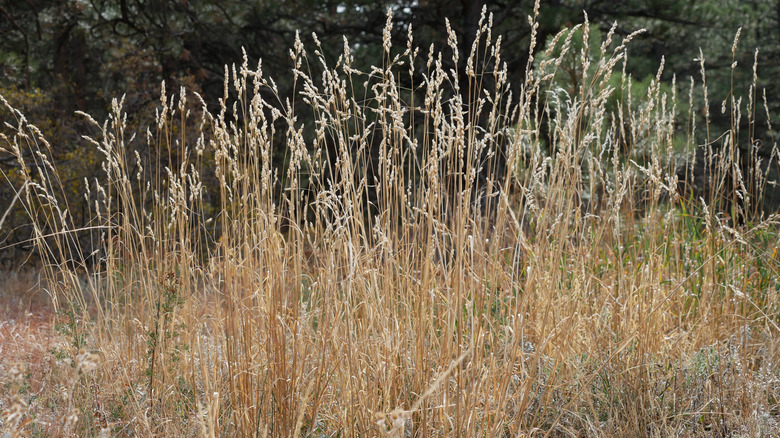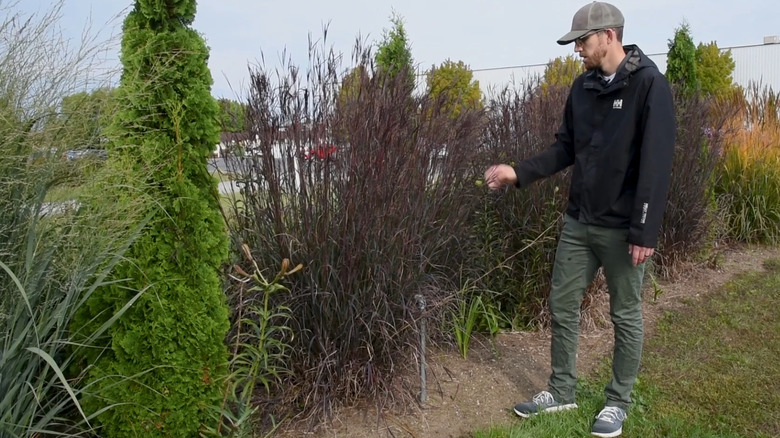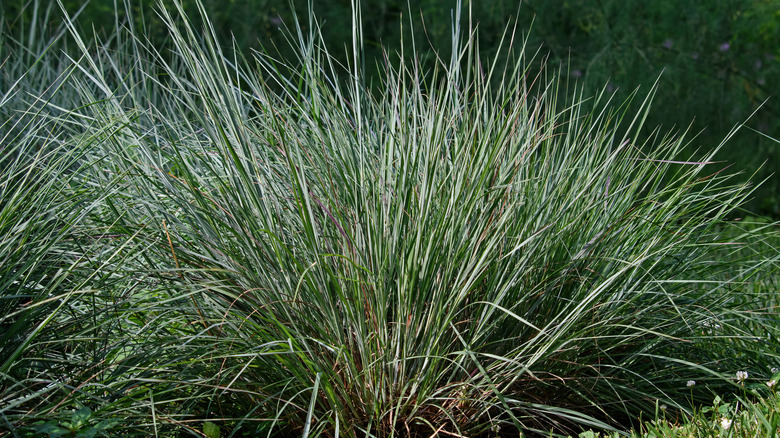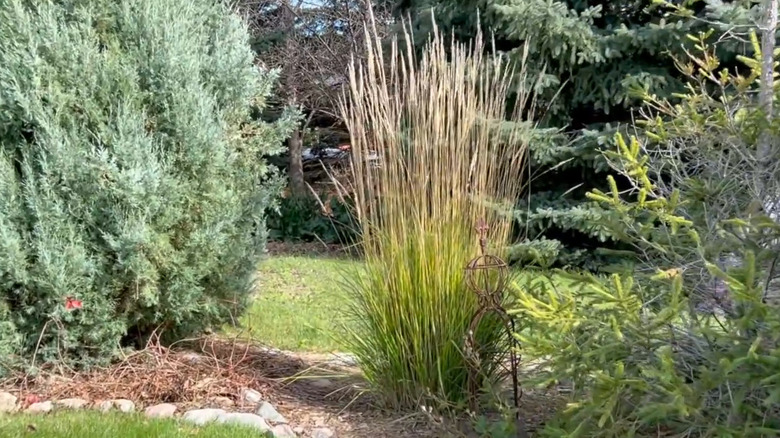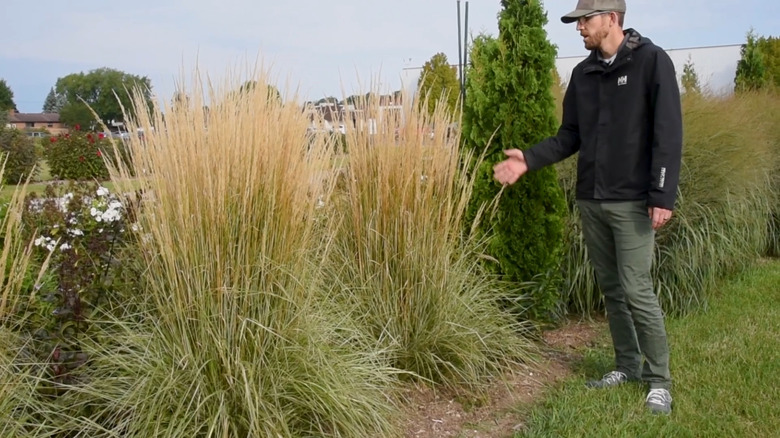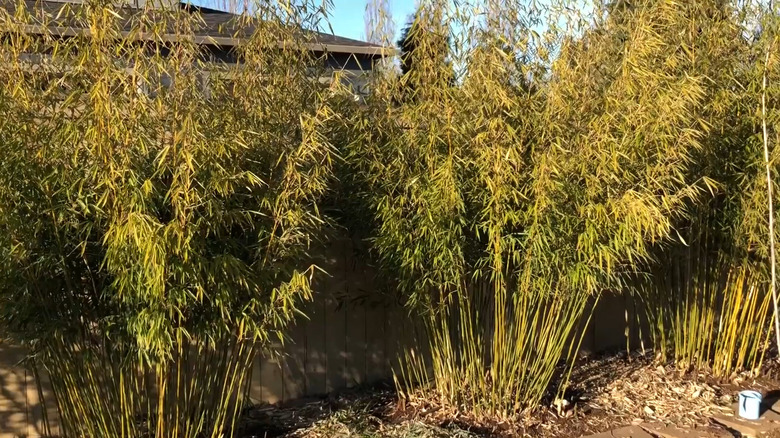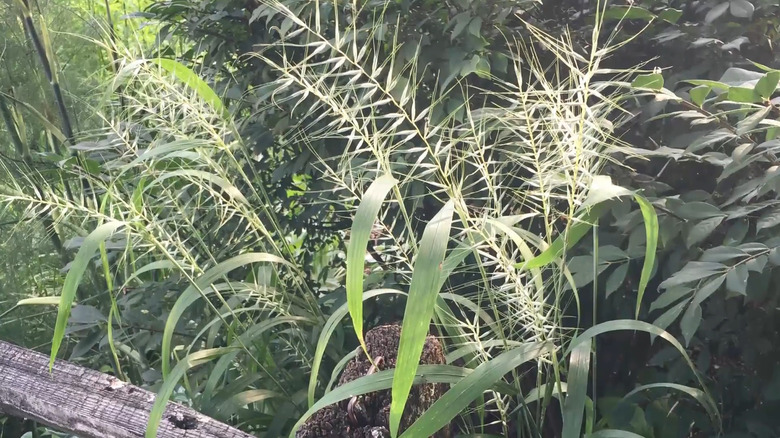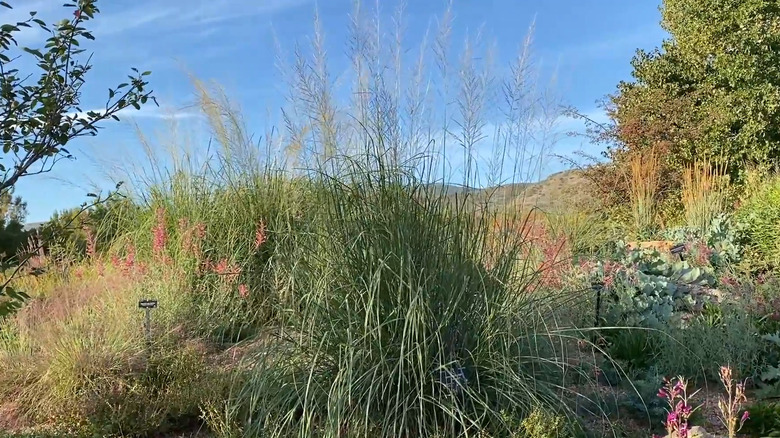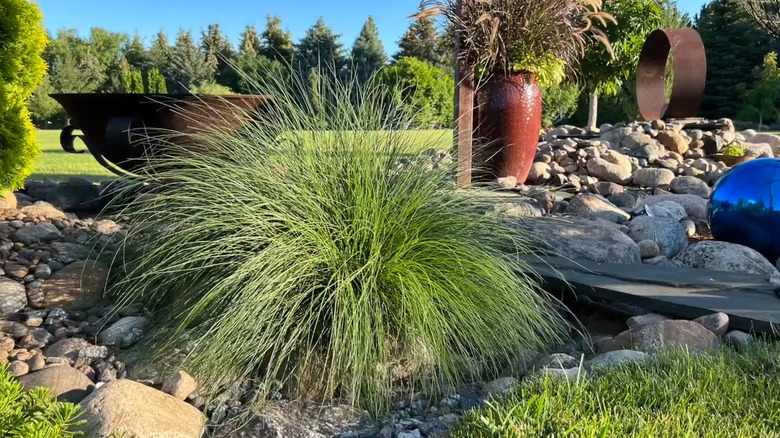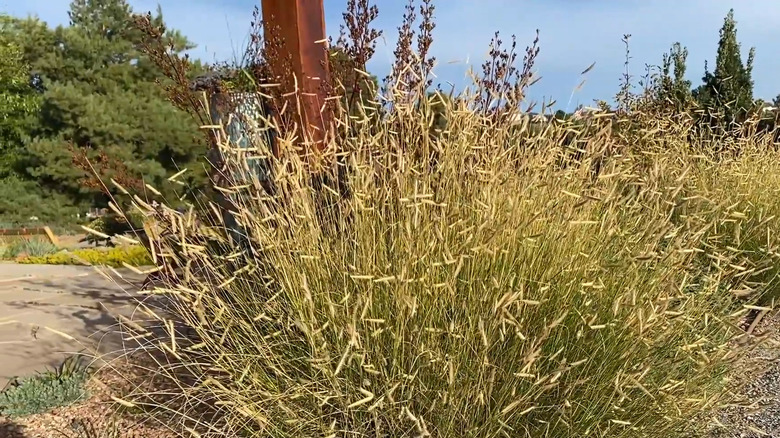18 Pampas-Like Ornamental Grass Options To Add Texture To Your Yard
After the discovery of the Americas in the 15th century, Europeans brought back many types of plants that gardeners take for granted today, including potatoes, sunflowers, and tomatoes. Pampas grass (Cortaderia selloana) is another important plant that made its way across the ocean, arriving in Europe in the 19th century. Today, while it's still broadly popular around the world, there are many reasons why planting pampas grass can be a huge mistake. Instead, gardeners are turning to a variety of alternative ornamental grasses to add texture and movement to their landscaping.
While pampas grass is only hardy in USDA Hardiness zones 8 to 10, there are varieties for every region, soil type, and growing condition. Many ornamental grasses are well-suited to dry gardens with poor soils. As low-maintenance plants that provide multi-seasonal interest, tall grasses such as pampas add a vertical element to your landscape that can create privacy, hide unsightly views, or be used as a focal point. Many ornamental grasses also don't require fertilizer; in fact, overfertilization can cause them to fall over.
With its giant plumes and tall stature, pampas grass is one of the most well-known ornamental grasses, and there's really no substitute for its magnificence. However, it can be invasive in some locations, and at least four countries have made it illegal to cultivate. For those living in cooler climates, plants such as switchgrass and big bluestem offer a hardier choice with similar advantages, including height, color, and beautiful plumes that add texture to your yard.
Pink muhly grass
Ornamental grasses such as pink muhly grass (Muhlenbergia capillaris) rival the show-stopping effect of pampas grass and can enhance the look of your summer-blooming perennials. They also look incredible on their own, especially in mass plantings where they can create a field of color. Pink muhly grass is hardy in USDA Hardiness zones 5 to 9, and like many ornamental grasses, it is easy to grow. Tolerant of a variety of growing conditions, pink muhly grass is native to much of the southern United States and areas further south, including Mexico and Guatemala.
Purple fountain grass 'Rubrum'
Purple fountain grass (Cenchrus setaceus 'Rubrum') is another colorful ornamental grass to add to your landscape. Although purple fountain grass is well-known, if you're looking for it online, you might find it listed as Pennisetum x advena 'Rubrum'. The main source of confusion is that it has been reclassified, but many nurseries continue to call it by its old name. Most gardeners know it as purple fountain grass, and you often see it in summer and fall container gardens. Since it's hardy in USDA Hardiness zones 9 to 11, it's often grown as an annual in cooler climates.
Pennisetum glaucum 'Purple Majesty'
Ornamental millet (Cenchrus americanus 'Purple Majesty,' previously Pennisetum glaucum) is another annual grass in the same genus as purple fountain grass. Grown in USDA Hardiness zones 2 to 11, this is a warm-season annual grass that's heat and drought-tolerant, adding color and texture to your garden through summer and fall. Although it reaches heights of 3 to 6 feet tall in a single season, ornamental millet has lower than average water needs. The striking purple flower spikes are up to 12 inches long, making it a stunning choice for mass plantings.
Moor grass 'Skyracer'
When it comes to tall ornamental grasses, there are so many delightful pampas grass alternatives out there that it's hard to know where to start, but moor grass (Molinia caerulea ssp arundinacea 'Skyracer') is as good a place as any. This cultivar will reach 6 feet tall or higher, turning a beautiful yellow color in the fall. Originating in Europe and Asia, Molinia is hardy to USDA Hardiness zones 5 to 8. It's also somewhat drought-tolerant, so it's a good choice for any large space with well-drained soil, including rock gardens, pond areas, meadows, and border plantings.
Switchgrass 'Totem Pole'
The tall, columnar growth habit of the Totem Pole cultivar of switchgrass (Panicum virgatum 'Totem Pole') is one of its standout features. Reaching up to 6 feet tall, this switchgrass cultivar boasts golden flowers atop bluish foliage, creating a stunning display in USDA Hardiness zones 4 to 9. Panicum virgatum cultivars are often selected for being deer resistant, a trait many tall ornamental grasses share. This one has thick, dense columns of stalks that stay upright, creating an ideal screen or hedge when planted in rows or masses. It's also frequently used as a focal point in naturalistic landscaping birds love.
Switchgrass 'Northwind'
Panicum virgatum 'Northwind' is another switchgrass cultivar that's hard to pass up when you're looking for pampas-like grasses. If you're looking for a tall ornamental grass hardy in USDA Hardiness zones 5 to 9 to build a gorgeous windbreak, Northwind will add an eye-catching texture to your landscape. Like Totem Pole, this switchgrass cultivar has a tall, upright habit with olive to bluish-green foliage. Throughout the summer, it provides visual interest and movement, but it shines at its best in the fall when it turns a lovely shade of yellowish orange that lasts through winter.
Yellow Indiangrass
With grasses such as yellow indiangrass (Sorghastrum nutans), it can be a little surprising how they go from a moderately sized clump in the spring and early summer to a 5-foot-tall specimen once they send up their flower stalks. Like other warm-season perennial grasses, yellow indiangrass can be pruned from late winter to early spring. This native prairie grass is hardy in USDA Hardiness zones 4 to 9, creating texture throughout the winter. Many growers leave it as long as possible to provide habitat for birds and visual interest in the garden whenever the wind blows.
Indiangrass 'Thin Man'
Sorghastrum nutans 'Thin Man' is another indiangrass cultivar and native species from New Mexico that requires little water. It's hardy in USDA Hardiness zones 4 to 9, reaching a mature height of 6 feet. Often used to add texture to the landscape, Thin Man has striking blue stems and leaves with contrasting golden flowers. Whether placed in front of a wall or used in mass plantings to create a windbreak, Thin Man adds structure and texture to your landscape. Able to tolerate a wide range of conditions, indiangrass cultivars also help prevent erosion.
Big bluestem grass
Big bluestem grass (Andropogon gerardii) reaches up to about 8 feet tall, giving the tallest of ornamental grasses a run for their money. It's one of the more famous prairie grasses from the Midwest of North America. Once established, big bluestem grass is drought-tolerant, but it can also be used in moist areas. It needs full sun, is hardy in USDA Hardiness zones 4 to 9, and can be used in butterfly gardens. This grass blooms red and the flowers become even darker into the fall months.
Big bluestem grass 'Blackhawks'
There are a couple of big bluestem cultivars, including a dark purple variety called Andropogon gerardii 'Blackhawks'. All of the cultivars of this species are hardy in USDA Hardiness zones 4 to 9 and have the same trademark turkey foot-shaped inflorescence. With 'Blackhawks', everything is dark purple, turning to black as the growing season moves forward. By fall, this big bluestem is an enchanting dark backdrop for other fall plants. It's also one of the best types of prairie grasses to grow to add privacy to your yard or patio.
Little bluestem 'The Blues'
Little bluestem (Schizachyrium scoparium 'The Blues') isn't actually little, and it's not closely related to big bluestem. At about 4 feet tall, it's not as tall as many of the other pampas grass alternatives, but what it lacks in stature it makes up for in impact. Little bluestem 'The Blues' is sought after for its vibrant blue color, bronze flower heads, and graceful texture. With a beautiful arching form, it provides plenty of color through winter in USDA Hardiness zones 3 to 9. A tough grass, little bluestem is seemingly unaffected by deer, insects, and drought.
Feather reed grass 'Karl Foerster'
It can be hard to nail down a description for many of the tall ornamental grasses, including ones like Karl Foerster feather reed grass (Calamagrostis x acutiflora 'Karl Foerster'). Starting as a bright green clump, the Karl Foerster seed head goes through a rainbow of shades throughout the year, from green to pink and bronze to tan. Even with the changing colors from season to season, feather reed grass cultivars are highly recognizable because of their shape. Often used in residential xeriscaping borders and flower beds, feather reed grass is hardy in USDA Hardiness zones 5 to 9.
Feather reed grass 'Hello Spring'
Another Calamagrostis x acutiflora cultivar to look for is 'Hello Spring.' Growing with the same shape and habit as Karl Foerster, this feather reed grass has a variegated leaf and a lighter overall color. The structure of this ornamental grass is nice and upright, and although its seed heads can't really compare to pampas grass, this is still a beautiful specimen that has a place in gardens in USDA Hardiness zones 4 to 11. The crisp white and green foliage contrasts nicely with the golden and tan seed heads rising up to 5 feet high.
Clumping bamboo 'Campbell'
While many people don't think about it, bamboo plants are actually grasses. Gardeners often avoid them because some are extremely invasive and shouldn't be planted in your yard. However, clumping bamboo species such as Fargesia robusta 'Campbell' are non-invasive cultivars that can be used in many of the same ways as pampas grass. Whether it's to create a hedge, a privacy screen, or add greenery and movement to your landscape for USDA Hardiness zones 5 to 8, Fargesia robusta is widely regarded as a bamboo variety that won't invade your yard.
Bottlebrush grass
Few grasses have a flower quite as exquisite as the bottlebrush grass (Elymus hystrix). When it comes to jaw-dropping ornamental grasses, this one certainly isn't backing down from pampas grass. There's something else unusual about this native grass species — it prefers dappled sunlight, so you can use it in the shadier parts of your yard. Most other tall ornamental grasses require full sun to stay strong and upright. Bottlebrush pairs well with other interesting textures, and is hardy in USDA Hardiness zones 5 to 9.
Giant sacaton grass
Giant sacaton grass (Sporobolus wrightii) is the largest native prairie grass in North America, and can be used as a substitute for other grasses such as pampas grass and Miscanthus cultivars, which can be invasive. Reaching as high as 8 feet tall, giant sacaton grass has delicate flower spikes in colors ranging from tan to bronze. This is a hardy grass in USDA Hardiness zones 5 to 9, and a southwest native. Give each plant plenty of room, because they can grow up to about 4 feet wide.
Prairie dropseed grass
When it comes to height and flowers, prairie dropseed grass (Sporobolus heterolepis) doesn't actually have that much in common with pampas grass. However, both of them offer a big impact when it comes to aesthetics, in addition to being low-maintenance. Prairie dropseed is a much hardier grass that grows in USDA Hardiness zones 3 to 9, and it only gets about 2 to 3 feet tall and wide, so it's a much more versatile plant. It's also listed as endangered in a handful of eastern states, providing another good reason to grow it.
Blue grama grass 'Blonde Ambition'
Another ornamental grass that offers significant visual interest without the height of pampas grass is blue gramma (Bouteloua gracilis 'Blonde Ambition'). This specific cultivar is an award-winning selection known for its resistance to pest and its unique light yellow, flag-type seed heads; hence the name blonde. When it comes to adding texture and bright color to your winter landscape design, Blonde Ambition is a safe, water-wise choice. Hardy in USDA Hardiness zones 3 to 10, this blue gramma cultivar is easy to grow in meadows, rock gardens, and mass plantings.
